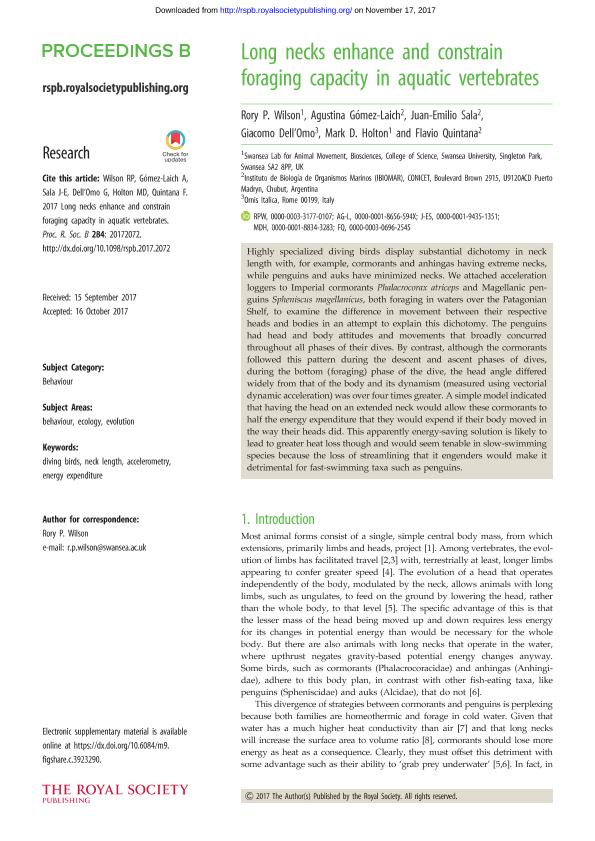Artículo
Long necks enhance and constrain foraging capacity in aquatic vertebrates
Wilson, Rory P.; Gómez Laich, Agustina Marta ; Sala, Juan Emilio
; Sala, Juan Emilio ; Dell´Omo, Giacomo; Holton, Mark; Quintana, Flavio Roberto
; Dell´Omo, Giacomo; Holton, Mark; Quintana, Flavio Roberto
 ; Sala, Juan Emilio
; Sala, Juan Emilio ; Dell´Omo, Giacomo; Holton, Mark; Quintana, Flavio Roberto
; Dell´Omo, Giacomo; Holton, Mark; Quintana, Flavio Roberto
Fecha de publicación:
11/2017
Editorial:
The Royal Society
Revista:
Proceedings of the Royal Society of London. Series B: Biological Sciences
ISSN:
0962-8452
Idioma:
Inglés
Tipo de recurso:
Artículo publicado
Clasificación temática:
Resumen
Highly specialized diving birds display substantial dichotomy in neck length with, for example, cormorants and anhingas having extreme necks, while penguins and auks have minimized necks. We attached acceleration loggers to Imperial cormorants Phalacrocorax atriceps and Magellanic penguins Spheniscus magellanicus, both foraging in waters over the Patagonian Shelf, to examine the difference in movement between their respective heads and bodies in an attempt to explain this dichotomy. The penguins had head and body attitudes and movements that broadly concurred throughout all phases of their dives. By contrast, although the cormorants followed this pattern during the descent and ascent phases of dives, during the bottom (foraging) phase of the dive, the head angle differed widely from that of the body and its dynamism (measured using vectorial dynamic acceleration) was over four times greater. A simple model indicated that having the head on an extended neck would allow these cormorants to half the energy expenditure that they would expend if their body moved in the way their heads did. This apparently energy-saving solution is likely to lead to greater heat loss though and would seem tenable in slow-swimming species because the loss of streamlining that it engenders would make it detrimental for fast-swimming taxa such as penguins.
Palabras clave:
Accelerometry
,
Diving Birds
,
Energy Expenditure
,
Neck Length
Archivos asociados
Licencia
Identificadores
Colecciones
Articulos(IBIOMAR)
Articulos de INSTITUTO DE BIOLOGIA DE ORGANISMOS MARINOS
Articulos de INSTITUTO DE BIOLOGIA DE ORGANISMOS MARINOS
Citación
Wilson, Rory P.; Gómez Laich, Agustina Marta; Sala, Juan Emilio; Dell´Omo, Giacomo; Holton, Mark; et al.; Long necks enhance and constrain foraging capacity in aquatic vertebrates; The Royal Society; Proceedings of the Royal Society of London. Series B: Biological Sciences; 284; 1867; 11-2017; 1-8
Compartir
Altmétricas



